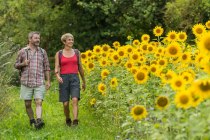Ingelheimer Höllenweg (Hell's Path of Ingelheim)
Hello Pinot!
The vineyard was first mentioned in a document in 1355 with the name "ame heldewege". So, where does the word “hell” come from? The name "hell" is derived from the Middle High German word for "Halde(a)" and means slope, therefore it has nothing to do with purgatory. In west-central Germany, this field name is very widespread. The small single vineyard, only eleven hectares in size, is predestined above all for mineral Pinots, with an almost salty finish.
> To the other single vineyard sites of Ingelheim: Horn, Pares, Rotes Kreuz and Schloss Westerhaus
> Experience Ingelheim on the fruit route via bike: https://www.rheinhessen.de/radrouten-rheinhessen/obstroute
> Ever visited the Ingelheim Imperial Palace? https://www.kaiserpfalz-ingelheim.de/
> Rheinhessen blog: https://blog.rheinhessen.de/auf-den-spuren-des-mittelalters-mit-der-kunsthistorikerin-durch-die-kaiserpfalz-in-ingelheim/






















